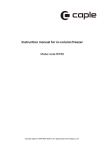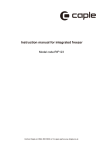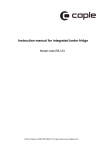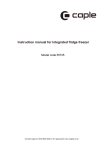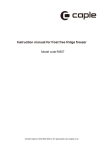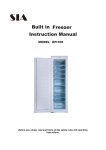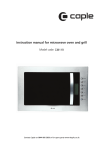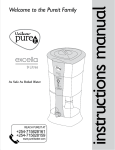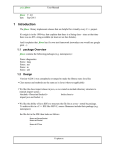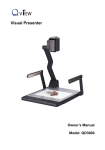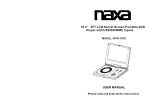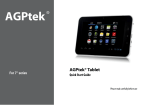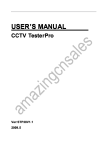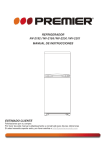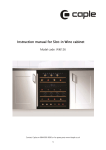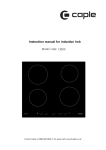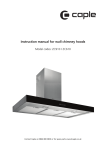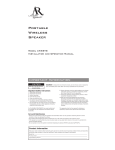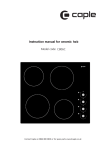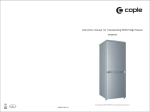Download Instruction manual for integrated freezer
Transcript
Instruction manual for integrated freezer Model code:RIF178 Contact Caple on 0844 800 3830 or for spare parts www.4caple.co.uk European Safety Certificate Compliance Declaration The manufacturer assumes full responsibility for the compliance of products manufactured with relevant safety, health and environmental protection requirements set out in European Directives. Test reports are available for verification upon request. The manufacturer will present the quality certificate or manufacture license to a refrigerator dealer if so required. Furthermore, the manufacturer declares that all parts intended to be in contact with fresh food as described in this User’s Manual are free of toxic substances. The symbol on the product or on its packaging indicates that this product may not be treated as household waste. Instead it shall be handed over to the applicable collection point for the recycling of electrical and electronic equipment. By ensuring this product is disposed of correctly, you will help prevent potential negative consequences for the environment and human health, which could otherwise be caused by inappropriate waste handling of this product. For more detailed information about recycling of this product, please contact your local city office, your household waste disposal serice or the shop where you purchased the product. 1. Compression-type appliances which use flammable refrigerants shall be marked with the symbol “Caution: risk of fire”. Caution:risk of fire The height of the triangle in the symbol “Caution: risk of fire” shall be at least 15 mm. 2. – WARNING: Keep ventilation openings, in the appliance enclosure or in the built-in structure, clear of obstruction. – WARNING: Do not use mechanical devices or other means to accelerate the defrosting process, other than those recommended by the manufacturer. – WARNING: Do not damage the refrigerant circuit. – WARNING: Do not use electrical appliances inside the food storage compartments of the appliance, unless they are of the type recommended by the manufacturer. Do not store explosive substances such as aerosol cans with a flammable propellant in this appliance. 3. If the supply cord is damaged, it must be replaced by a special cord or assembly available from the manufacturer or its service agent. This appliance is not intended for use by persons (including children) with reduced physical, sensory or mental capabilities, or lack of experience and knowledge, unless they have been given supervision or instruction concerning use of the appliance by a person responsible for their safety. Children should be supervised to ensure that they do not play with the appliance. Content Page 1. Environmental Protection and Proper Disposal........2 2. Location....................................................................2 3. Installation ...............................................................2-3 4. Rating Plate..............................................................3 5. Electric Connection ..................................................3 6. Operation Instructions...............................................3-4 7. Freezer Compartment ..............................................4 8. Ice & Ice Cream Making ...........................................5 9. Preparing for Vacation .............................................5 10.Cleaning & Maintenance .........................................5 11.Defrosting ...............................................................5-6 12.Problem Diagnosis ..................................................6 13.Troubleshooting ......................................................6-7 14.During a Power Interruption.....................................7 15.Making A Service Call .............................................7 16.Installation In Kitchen ..............................................7 17.Warranty..................................................................7 18.Illustration of Parts...................................................7 Please read these instructions carefully before use. Underline the important in structions. Keep the User ’s Manual in a safe place for later reference. Remember to hand it over to the owner, if you ever sell the appliance. What you have bought is a safe and reliable refrigerator. With appropriate use and maintenance, it will be in service for years. The last page of this User’s Manual sets out specifications of this appliance and the performance dat a indicated in the rating plate are test results obtained at an ambient temperature range of 16~32°C. Important! Important! It must be noted that a refrigeration system contains refrigerants, which require specialised waste disposal. Contact your local waste disposal center for proper disposal of an old appliance and contact your local authority or your dealer if you have any question. Please ensure that the pipe work of your refrigerator does not get damaged prior to being picked up by the relevant waste disposal center, and contribute to environmental awareness by insisting on an appropriate, anti-pollution method of disposal. Please see the rating plate for the type of refrigerant and insulation used. The plug should be accessible after the appliance is positioned. If the power c ord is damaged, it must be replaced with a new power cord from the manufacturer or an authorised service agent. Caution: The appliance should be installed in a well ventilated place. The packaging should be removed. Caution: Do not use a sharp or pointed items to defrost. Caution: Make sure the refrigeration system is not damaged. It is intended strictly for household use. Not to be used for industrial or commercial purpose. Be sure to observe the relevant norms and regulations. A leakage test has been conducted in accordance with relevant safety standard. To avoid the risk of child entrapment, please make sure your old refrigerator is inoperative and safe by removing the latches and bolt locks before disposal. Caution: Do not use electrical appliances inside the food storage compartments of the appliance, other than models recommended by the manufacturer. This User Manual is applicable to a variety of models and there may be slight changes in certain aspects from model to model. 1 1.Environmental Protection and Proper Disposal 3.Installation Package materials b) Remove items in the refrigerator. The appliance is packaged in a way to prevent damages during transportation. Recyclable materials are used. The packing box is made of corrugated board / cardboard (mainly from recycled paper). ·Polystyrene parts (CFC-free foamed polystyrene) ·Linings and polyethylene bags a) Remove all packaging materials. c) Make sure to remove film and tape on the cabinet and the door. d) Remove polystyrene chips (if any) around the refrigerator. e) Take out accessories and literature in the refrigerator. f) Clean the inside of the refrigerator with luke warm water and vinegar and then dry it with a soft cloth. g) Use the spanners supplied to adjust the leveling leg to ensure the refrigerator is stable. ·Polypropylene straps All these valuable materials may be taken to a waste collecting center and used again after adequate recycling. All waste materials should be disposed of properly. Do not us e detergents, sharp or pointed instruments or soda-based cleansers to clean the refrigerator. · 2.Location Make sure the refrigerator is kept upright during handling. If an inclination is required, it should not exceed 45 degrees. Other wise the appliance may get damaged resulting ompromised refrigeration performance. To avoid product damage or person injury, the refrigerator should be un packed b y two per sons after it is located in a previously selected position. · The refrigerator should be used for its intended purpose only. · The refriger ator should be positioned on a solid and even floor to ensure refrigerant circulation and refrigerating performance. · If possible, position the refrigerator in a cool and dr y well ventilated room. · Do not expose the refrigerator to direct sunshine and make sure the ambient temperature is not extremely high. · Before installation, make sure the refrigerator has no visible exterior damage. When handling the refriger ator, do not lift it by holding the worktop, to prevent any damage to the refrigerator. Do not start up a refrigerator that is damaged. Before installation, make sure the refrigeration system is free of any damage. Keep the refrigerator from a heat source, such as heating sustem, oven or cookers. Otherwise the compressor will operate more frequently resulting in extra power consumption. If the refrigerator will be placed near a h eat source, it is recommended to install a thermal barrier between the refrigerator and the heat source (asbestos is prohibited) or maintain adequate space between the refrigerator and the heat source as follows: Check the refrigerator carefully for: - Damaged package due to inappropriate handling during transportation the heat source as follows: Cooker or electric stove Radiator or oven Another refrigerator 3 cm 30 cm 2 cm - Damage in the exterior - Damage in power cord / plug Any doubt, please contact Customer Service for a thorough inspection of the appliance. Take necessary measures to prevent leakage of refrigerant at the start-up of refrigerator that may resu lt in environmental pollution. Do not place any radiating apparatus, such as microwave oven or toaster, on top of the refrigerator. Make sure the air vent is not obstructed. Never unplug the refrigerator by pulling on the power cord. Always grip the plug firmly and pull it strai ght out from the outlet. 2 Warning! After the refrigerator is positioned, allow it to stand still for at least 12 hours before starting it up to ensure stable refrigerant circulation and faultless operation. Write down the technical data for later reference to avoid the need for moving the refrigerator when such data is needed. Model / Type Danger! Storage............................................................... Liter Working voltage…………………………………… Volt Max input power (W) ……………………………… Watt Current……………………………………………... Amp Energy consumption …………………………….. kWH/24hr Freezing capacity ………………….. kg/24hr Depending on the chemical composition, the refrigerant may be flammable. The leak-proofness of refrigerant circulation system is test proven. Unauthorised intervention of the refrigerant circulation system may cause fire. 5.Electric Connection Before starting up the refrigerator, make sure the inner compartment is dry (especially corners). Make sure the refrigerant circulation system and the peripheral parts of compressor are not affected. Any intervention of the refrigerating system should be conducted only by qualified engineers. The refrigerator should use a properly grounded outlet which should be checked by a qualified electrician. The refrigerator should always be plugged into its own individual electrical outlet which has a voltage rating and a fuse rating in conformity with the rating plate. In case of nonconformity, consult the local service center or the dealer immediately. Warning! The refrigerator should not be connected with a converter (such as solar cell) Refrigerant getting into eyes can cause serious inj ury. In this case, rinse the eyes under running water and consult an ophthalmologist without delay. Do not use an extension cord. The refrigerator should be used within an appropriate range of room temperature by its climate type. The range of room temperature for a sp ecific climate type should be observed. See the rating plate for the climate type of your appliance. Climate type Room temperature SN +10°C~+32°C N +16°C~+32°C ST T +18°C~+38°C +18°C~+43°C 6.Operation instructions a) Power on the refrigerator (or power off), and select temperature settings · Temperature regulator (thermostat) · Temperature regulator is used to power on/off the refrigerator, and select temperature settings. b) Startup Turn the temperature regulator clockwise to startup the refrigerator. (Turn to restricted position at most, or you may break the temperature regulator). Compressor starts operation, until the interior temperature satisfies the settings. 4. Rating Plate A rating plate is found on the side panel or back panel of the refrigerator, indicating important technical data. Write down these technical data. c) Setting temperature In order to adjust the setting of temperature regulator of freezer compartment, use the key supplied by the manufacturer and turn the temperature regulator clockwise or anticlockwise to a desired setting. To select a lower temperature: Turn clockwise Write down the following technical data. To select a higher temperature: Turn anti-clockwise 3 Turn temperature reg ulator counterclockwise to the lowest setting = lightest cooling; (Turn the regulator counterclockwise to the most will power off the refrigerator, compressor will stop) Turn temperature regulator counter clockwise to the highest setting = coldest setting; Temperature setting should conform to the following conditions: · Ambient temperature; · Quantity of food stored; · Door openings; Through observation, you’ll soon learn how to select an appropriate temperature setting. Appropriate t emperature setti ng is very imp ortant for food storing. Microbes can get food spoiled very quickly, unless there growth is stunted by low a temperature environment. It is recommended to set the t emperature to 18°C or lower which may effectively eliminate food spoiling process by microbes. d). Stopping Turn temperature regulator fully counterclockwise. The compressor should then stop. Unplug from wall outlet. 7.Freezer compartment storage, select a medium setting. 4 Normally, when food requires a long period of stor age, select a high setting. NOTE! · Never add canned or bottled carbon dioxide drinks to the freezer, as carbon dioxide may expand when under freezing, and lead to an explosion hazard. · Bottled food which needs immediate cooling should be stored in the freezer for no more than one h our befor e they’re taken out, otherwise bottles may burst. · Ice cream should be allowed several minutes before using, as lips and tongue may get frostbite (chap may occur in skin). Mean while, avoid touching inner walls of freezer with wet hands. IMPORTANT! · Food to be added to freezer must be well wrapped. · Observe expiration date of frozen food. · Only high quality fresh food is suitab le for freezer storage. · Food stored in freezer should be properly sized. · Weight of a single package of frozen food should not exceed 2 kg. · Please use reusable plastic film, aluminum film for packing food, or put food in containers. 3-star or 4-star freezer are suitable for storing deep frozen · Food packages should not entrap too much air inside. food (alre ady frozen before a dded to the freezer), storing fresh food for a short period (2-3 weeks) by freezing it, or making ice, ice cream and water ice. · Use bunge, clip, rope or freezing-resistant tape for sealing of food package. Recommended expiration date of food must be observed. Freezer can be used to produce ice cubes. 1.Temperature within the freezer can be adjusted by setting tempeature regulator. For fresh food and food which needs to be stored for a long period, -18°C or below is recommended, as microbes can barely survive under this temperatur e. Once the temperature is higher than -10°C, microbes will start to caus e spoil ing of food, and storage period of food will be effectively red uced. If you need to freeze food which is already partly or totally thawed, please cook it before adding it to the freezer again. The high temperature of cooking process can eliminate most microbes. 2 The higher the temperature regulator is set, the lo wer the temperature within the freezer will be. 3 Normally, when food requires only short period of · Film welding device can be used to seal the plastic packages. · Place the wide side of food package downward to obtain a faster freezing process. · Wipe the packages dry before adding them to the freezer, as they may stick together when frozen. · If you need to freeze food which is already partly or totally thawed, please cook it before adding it to the freezer again. · Don’t use food which is already expired, as they may cause poisoning. 8.Making ice cubes, ice cream 4 Making ice cubes: · Add water to ice tray to 3/4 of its volume , place it at the bottom area of the freezer. When ice cubes are read y, flush the ice tray with running water, then, you cnn easily take out the ice cubes. Making ice cream: · Remove separators of the ice tray. Please note the creamier your ice cream is, the longer it will take to make it. When ice cream is ready, flush the ice tray with running water, then, you can easily take out the ice cream. 9.Preparing for Vacation For long vacation or absence, unplu g the refrigerator and clean the refrigerator as described in “ Cleaning and Maintenance”. Leave the doors open to prevent formation of mould or odour. 10. Cleaning and Maintenance Unplug or disconnect the appliance before cleaning. Keep the outside clean. Use furniture polishe or finishing conditioner to clean the outside regularly (do not use these cleaners to cle an the inside). Wipe the door gasket with a cloth lightly dampened with lukewarm water. No det ergent is allowed. Never use oil or grease to clean the door gasket. Clean the inside regularly. · Clean the refrigerator compartment on a monthly basis and clean the freezer compartment after a defrost cycle. · Take out foods from refrigerator and freezer compartments and kept these foods in a cool place. · Remove all detachable parts. · Interior parts are not suitable to be washed in a dishwasher. Wash them manually using luke warm water and some dish detergent. Do not use concentrated detergent, abrasive agents and chemicals such as acids. Mild dish detergent is recommended. Steam cleaners are dangerous and strictly prohibited. Wash the inner compartment with lukewarm clean water and dry with a soft cloth. It is absolutely dry after waiting for 3-4 minutes. Do not destroy or remove the rating plate of the refrigerator. It could be needed for after-sales service or relevant processes. Make sure water doesn’t get into electric parts in the refrigerator. If a heat exchanger, i.e. condenser, is mounted on the back of refrigerator, dust and lint should be removed regularly to enable efficient heat dissipation and avoid excessive power consumption. Use a soft brush or a duster to clean the outside of heat exchanger. The defrost water drains away through the gutter. The drain hole should be cleaned regularly by use of a swab or similar instrument. Make sure water doesn’t run down the drain hole during cleaning. Otherwise water may spill or splash on the ground due to evaporation. 11. Defrosting Freezer compartment (if applicable) The freezer compartment, intended for storage of frozen food, doesn’t have automatic defrosting. The freezer compartment should be defrosted regularly. Defrost the freezer compartment whenever the thickness of ice layer reaches 5cm. Unplug the refrigerator before defrosting. Take out foods from the freezer compartment and kept these foods in a cool place. Use an ice scraper to remove the ice. To speed up the process, place a bowl of hot water in the freezer compartment. Clean and reload the freezer compartment after defrosting. POTENTIAL SAFETY HAZARD! Do not use electrical devices such as hair dryer, electrical fan, steam cleaner, defrost spray or open fire (such as candle) to defrost the freezer compartment. The plastic parts of inner compartment may get melted and any spark or open fire may cause fire in presence of explosive gas. Never use a steam cleaner to defrost the freezer compartment – danger of electric shock!) Cautions! Take out the drawer, and wrap up the frozen foods with newspaper or blanket. ·Keep these foods in a cool place before the defrosting process is finished. ·Keep the door of freezer compartment open. · Ice and frost form on the surface of evaporator during operation. A thick layer of ice or frost acts as heat insulation and hinders thermal conduction. · Defrost the freezer compa rtment in the shortest time possible to avoid thawing of frozen foods. · Do not remove the ice or frost in the freezer compartment with a sharp or pointed item. Otherwise 5 the evaporator surface may get damaged. · Wipe off defrosted water from time to time with a sponge. · Place a container of hot water (do not use boiling water) near the door of freezer compartment to speed up the defrosting process. · Dry the freezer compartment and place the frozen food back. · Reconnect the refrigerator after defrosting. · Start up the refrigerator by adjusting the temperature control knob. · Close the door of freezer compartment. 12. Problem Diagnosis The latest manufacture techniques a nd state-of-the-art refrigeration and freezing technology are adopted to ensure safe and reliable operation of your appl iance. In doubt of fault, make sure to check first as described below before making a service call: Things to be noted: The compressor (also known as refrigerating unit) doesn’t operate all the time without stop. The compressor is controlled by the automatic temperature regulator represented by a temperature dial. When the interior temperature exceeds the preset temperature, the compressor starts automatically and when the interior temperature falls below the present temperature, the compressor stops automatically. It’s normal that compressor makes noise during operation. The noise comes from the motor. The flo w of refrigera nt through the refrigerating system may maky a gurgling noise. These noises don’t mean a fault of the refrigerator. The exterior surface may be wet when it’s cold and the ambient tempe rature is low. It’s normal and the e xterior surface will become dry as the ambient temperature rises. If the reasons of such phenomena can’t be identifi ed and solved, please consult the service center. 13. Troubleshooting a) Problem: Re frigerator doe s not ope rate (doe s not work) Please check: · Is the power cord in good conditi on? Is the refrigerat or properly plugged in the outlet? · Is there a power int erruption? (Us e a small ap pliance to check out, e.g. agitator or hair dryer) · Is the refrigerator star ted up? (T he te mperature dial should not be set at “0”.) · Is the fuse broken? Or in poor contact? b) Problem: The inner compartment is not cool enough; the compressor cycles on and off frequently; Please check: · The refriger ator/freezer co mpartment should stand still for at least 12 hours after installation to stabilize the refrigerant circulation system. See “Start-up”. If it doesn’t work, unplug the refrigerator and tilt the refrigerator to one side for a while or place it on an inclined plane and then place it to the original position. Connect the refrigerator after 12 hours. Keep the door(s) closed for 12 hours. · Is the door properly closed? If so, the door gasket should press on the external cabinet securely and evenly. Test: It should be difficult to pull out a piece of paper caught up between the door gasket and the external cabinet. If the paper slips away easily, consult the service center. · If there is thick ice in the freezer compartment. (See “Cleaning and Maintenance”) · Is the refrigerator e xposed to direct suns hine or near a heat source (oven, radiator, etc.)? What to do: Do not expose the refrigerator to direct sunshine; keep the refrigerator away from any heat source; install a thermal barrier netween the refrigerator and the heat source (see “Location”). · Is the inner compartment overloaded? · Is the room well venti lated? Is the air vent obstructed? Is the heat exc hanger (condenser) on the b ack covered by dust? c) The temperature of refrigerator compartment is too low Please check: · Is the temperature regulator properly set? · Is the door of freezer compartment properly closed? · Is there a lot of fresh food (more than 1kg) in the freezer compartment? (If the freezer compartment operates for long periods, the temperature of refrigerator compartment falls accordingly.) d) The freezer compartment is too warm and frozen foods are thawed · Is the ambient temperature too low? (If so, the refrigerating unit will malfunction, resulting in higher temperatures in the freezer compartment.) What to do: Raise the ambient temperature. e) There is thick ice in the freezer compartment. Please check: · Is the door of freezer compartment properly closed? · If some food gets frozen to the inner walls, try to remove it with a blunt instrument such as a spoon 6 handle. · Defrost and clean the freezer compartment (see “Defrosting”). A thick ice layer will impede refrigeration performance and increase power consumption. f) Unusual noise Please check: · Is the refrigerator solidly positioned? Is the refrigerator rubbing against other furniture or items? Is there anything stuck between the back of refrigerator and the wall? · Move the items in contact with the refrigerator out of way and keep adequate space between the refrigerator and the surroundings. · Is the movable parts securely retained in place? · Are bottles or containers in the inner compartment rubbing against each other? 17. Warranty The terms and conditions as well as the period of warranty are indicated in the Letter of Warranty enclosed hereto. The dealer will brief you of the same upon purchase. The manufacturer reserves the right to improve the design, construction and technology from time to time without further notice. 18. Illustration of Parts Note! It’s normal that there is noise of refrigerant flowing through the refrigerating system. It’s normal that moisture forms around the door handle in summer. Dry with a soft cloth. The refrigerator is not user-serviceable and do not attempt to intervene with the normal operation of the appliance. 14. During a Power Interruption There is no need to take out the frozen foods in the freezer compartment if the power interruption lasts no more than 2 hours. Otherwise, take out the foods after 2 hours. 15. Making A Service Call 1 Thermostat Servicing and repair should be conducted by qualified Caple engineers. The manufacturer is not responsible for the risk of damages or injuries due to failure to comply with this provision and the warranty will be voided. The warranty and the list of service centers indicate the authorised after-sales service providers for your appliance. Please consult your dealer if the there is no service center in your neighborhood. For faults or problems caused due to improper use or breach of the instructions contained herein, the costs and expenses incurred in servicing and repair should be paid by the user and the dealer is not responsible for such costs and expenses. In order to receive prompt assistance, the following information is necessary: 2 Drawer 3 Lower hinge Levelng leg · Type and model of refrigerator (see the rating plate) · Date of purchase. · Name and address of the dealer. · Description of fault / problem. 16. Installation in Kitchen If you want to place the refrigerator in the kitchen, you should contact with professional installer or local service supplier.Please do not do it yourself. 7 Installation guide for built-in refrigeration Please carefully read this guide before installing the appliance. xx zz x yy y z Model X Y Z XX YY ZZ 1 1 2 RI734 540 1773 - 1778 540 550 - 560 1774 - 1782 560 2 2 RI733 550 1773 - 1778 540 560 1774 - 1782 560 RIR177 540 1773 - 1778 540 550 - 560 1774 - 1782 560 RI555 540 1773 - 1778 540 550 - 560 1774 - 1782 560 2 RI554 540 1773 - 1778 540 550 - 560 1774 - 1782 560 2 RIL177 540 1773 - 1778 540 550 - 560 1774 - 1782 560 1 RIF177 540 1773 - 1778 540 550 - 560 1774 - 1782 560 1 RIL122 540 1222 - 1224 540 550 - 560 1225 - 1233 560 1 RIF122 540 1222 - 1224 540 550 - 560 1225 - 1233 560 1 RIL88 540 873 - 875 540 550 - 560 874 - 882 560 1 RIF88 540 873 - 875 540 550 - 560 874 - 882 560 1 2 3 2 2 2 2 2 2 2 2 20 20 20 20 20 20 14 14 12 12 RI733 RIR177 RI555 RI554 RIL177 RIF177 RIL122 RIF122 RIL88 RIF88 2 2 2 20 RI734 Model 1 1 1 1 1 1 1 1 - - - 4 4 4 4 4 4 4 4 4 4 4 1 1 - - - - - - - - - - - 1 1 1 1 1 1 1 1 1 - - 1 1 1 1 1 1 1 1 1 0,9m 0,9m 1,3m 1,3m 1,8m 1,8m 1,8m 1,8m 1,8m 1,8m 1,8m 2 2 2 2 4 4 4 4 4 4 4 1 1 1 1 1 1 1 1 1 1 1 - - - - - - 1 1 1 1 1 - - - - - - 1 1 1 1 1 1 4 5 2 3 4 6 5 7 6

















